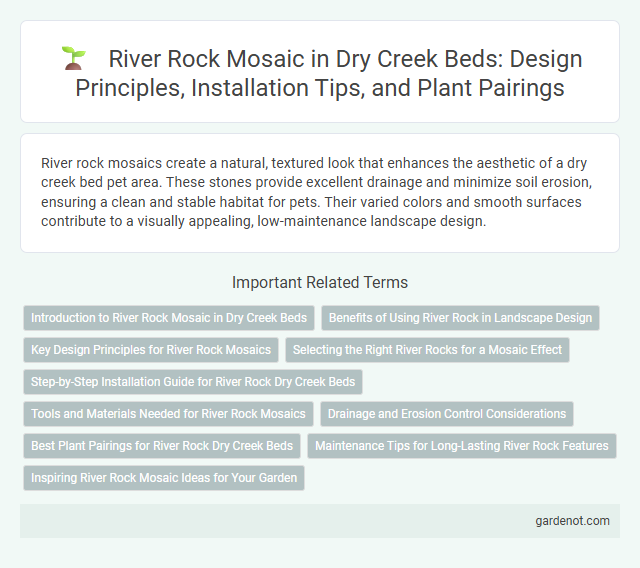River rock mosaics create a natural, textured look that enhances the aesthetic of a dry creek bed pet area. These stones provide excellent drainage and minimize soil erosion, ensuring a clean and stable habitat for pets. Their varied colors and smooth surfaces contribute to a visually appealing, low-maintenance landscape design.
Introduction to River Rock Mosaic in Dry Creek Beds
River rock mosaics in dry creek beds create visually striking patterns using smooth, naturally weathered stones that enhance drainage and prevent soil erosion. These mosaics incorporate varying sizes and colors of river rocks to mimic natural streambeds while providing a durable, low-maintenance surface ideal for garden landscaping. Integrating river rock mosaics into dry creek beds promotes sustainable water management by directing runoff and reducing sediment displacement.
Benefits of Using River Rock in Landscape Design
River rock in landscape design offers exceptional durability and natural aesthetic appeal, enhancing dry creek beds with a variety of colors and textures that blend seamlessly into outdoor environments. Its smooth, rounded stones improve water drainage and reduce soil erosion, making them ideal for sustainable landscaping projects. Incorporating river rock also minimizes maintenance needs due to their resistance to weathering and ability to suppress weed growth effectively.
Key Design Principles for River Rock Mosaics
River rock mosaics in dry creek beds emphasize natural flow and texture by selecting smooth, rounded stones of varying sizes to mimic water movement. Strategic placement based on color gradient and stone shape enhances visual depth and creates a dynamic, organic pattern that blends seamlessly with the surrounding landscape. Proper drainage planning and substrate preparation ensure durability and prevent erosion, maintaining the mosaic's structural integrity over time.
Selecting the Right River Rocks for a Mosaic Effect
Selecting the right river rocks for a dry creek bed mosaic involves choosing stones with varied sizes, colors, and textures to create visual interest and natural appeal. Smooth, rounded river rocks in shades of gray, brown, and rust mimic authentic streambeds and enhance drainage efficiency. Incorporating a mix of small pebbles and larger cobbles ensures stability and a balanced aesthetic for the mosaic effect.
Step-by-Step Installation Guide for River Rock Dry Creek Beds
Lay a weed barrier fabric over the dry creek bed area to prevent weed growth and stabilize the base. Arrange river rocks in varying sizes to mimic natural flow, starting with larger stones at the edges and filling the center with smaller pebbles for texture and drainage. Secure the rocks by tamping the soil around them and adding sand or fine gravel to fill gaps, ensuring long-lasting durability and aesthetic appeal in the dry creek bed installation.
Tools and Materials Needed for River Rock Mosaics
Creating a river rock mosaic requires essential tools such as a trowel, grout float, and tile nippers to shape and set the stones accurately. Key materials include smooth river rocks of varying sizes, durable grout for bonding, and a sturdy base like concrete or mesh backing for stability. Proper sealing materials protect the mosaic from weathering, ensuring long-lasting vibrant aesthetics in dry creek bed installations.
Drainage and Erosion Control Considerations
River rock mosaic enhances drainage by allowing water to permeate through the gaps between stones, reducing surface runoff and minimizing erosion in dry creek beds. The natural arrangement of varied-sized river rocks dissipates water flow energy, preventing soil displacement and maintaining landscape stability. Proper installation with a base layer of gravel improves infiltration, supporting effective erosion control and sustainable water management.
Best Plant Pairings for River Rock Dry Creek Beds
Succulents such as sedum and echeveria thrive alongside river rock dry creek beds due to their drought tolerance and low maintenance needs. Ornamental grasses like blue fescue and fountain grass complement the river rock textures while providing movement and height contrast. Native plants including lavender and Russian sage enhance the naturalistic appearance and attract pollinators, creating a balanced, sustainable landscape.
Maintenance Tips for Long-Lasting River Rock Features
To maintain a river rock mosaic in a dry creek bed, regularly remove debris and leaves to prevent organic buildup that can cause discoloration or moss growth. Use a gentle pressure washer or garden hose to clean stones, avoiding harsh chemicals that may degrade the rocks' natural color. Inspect the mosaic periodically for shifting stones and reset them promptly to maintain structural integrity and aesthetic appeal.
Inspiring River Rock Mosaic Ideas for Your Garden
Transform your garden with inspiring river rock mosaic ideas that enhance natural aesthetics and create stunning focal points. Use a variety of smooth, multicolored river rocks arranged in intricate patterns to add texture and visual interest to walkways, patios, or the edges of a dry creek bed. Incorporate mosaic designs depicting flowing water or natural elements to seamlessly blend with your outdoor landscape, promoting a tranquil and artistic garden environment.
River rock mosaic Infographic

 gardenot.com
gardenot.com